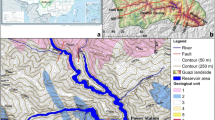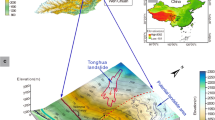Abstract
The reactivation mechanism and stability of ancient landslides are the major concerns in the tectonically active zone. A detailed case study has been conducted to examine the reactivation mechanism of ancient landslides in Southwest China by investigating the reactivation process, shear strength and stability. Field investigation suggests that the reactivation of ancient giant slides, such as the Luosiwan slide, is attributed to the cumulative effect of adverse geological, structural condition and intensive artificial processes. However, long-term observation has shown that the ancient giant landslides usually remain stable in the remote area in spite of such adverse conditions. Ring shear tests also indicate high peak shear strength of the sliding zone soils. However, the shear strength decreases significantly once displacement occurs at the toe of giant landslide due to engineering construction. The construction process could be considered as the critical triggering factor for the reactivation of ancient giant landslide, which exerts sudden changes in the forces acting on the slope. Both long-term adverse geological evolution and sudden change in the strength lead to the reactivation of giant landslide. This study also suggests that liquefaction plays an important role in the failure behavior of reactivated ancient landslide. An effective drainage system has to be set up during engineering construction so as to reduce the probability of reactivation of ancient landslides.










Similar content being viewed by others
References
American Society for Testing and Materials (1964) Laboratory shear testing of soils. Committee D-18 on Soils for Engineering Purposes, Philadelphia
Bathrellos GD, Gaki-Papanastassiou K, Skilodimou HD, Papanastassiou D, Chousianitis KG (2012) Potential suitability for urban planning and industry development using natural hazard maps and geological-geomorphological parameters. Environ Earth Sci 66:537–548
Bathrellos GD, Gaki-Papanastassiou K, Skilodimou HD, Skianis GA, Chousianitis KG (2013) Assessment of rural community and agricultural development using geomorphological—geological factors and GIS in the Trikala prefecture (Central Greece). Stoch Env Res Risk Assess 27:573–588
Carrubba P, Del-Fabbro M (2008) Laboratory investigation on reactivated residual strength. J Geotech Geoenviron Eng 134:302–315
Cheng Y, Lansivaara T, Wei W (2007) Two-dimensional slope stability analysis by limit equilibrium and strength reduction methods. Comput Geotech 34:137–150
Cruden DM, Varnes DJ (1996) Landslide types and processes. In: Turner AK, Schuster RL (eds) Landslides: investigation and mitigation. U.S. Transportation Research Board, Special Report 247, pp 36–75
Dai F, Wang S, Lee C (1998) The drained residual strength of volcanic derived soil sampled on Lantau island, Hongkong. J Eng Geol 6:223–229 (in Chinese)
Dai F, Lee C, Deng J, Tham LG (2005) The 1786 earthquake triggered landslide dam and subsequent dam-break flood on the Dadu River, southwestern China. Geomorphology 65:205–221
Dawson EM, Roth WH, Drescher A (1999) Slope stability analysis by strength reduction. Geotechnique 49:835–840
El-Ramly H, Morgenstern NR, Cruden DM (2002) Probabilistic stability analysis for practice. Can Geotech J 39:665–683
Futalan KM, Biscaro JRD, Saturay RM Jr, Catane SG, Amora MS, Villaflor EL (2010) Assessment of potential slope failure sites at Mt. Canabag, Guinsaugon, Philippines, based on stratigraphy and rock strength. Bull Eng Geo Environ 69:517–521
Holtz RD, Kovacs WD (1985) An introduction to geotechnical engineering. Prentice-Hall, pp 543–545
Hu M, Wang F, Cheng Q (2009) Formation of tremendous Yigong landslide based on high-speed shear tests. Chin J Geotech Eng 31:1602–1606 (in Chinese)
Huang R (2009) Some catastrophic landslides since the twentieth century in the southwest of China. Landslides 6:69–81
Hutchinson JN (1988) General report: morphological and geotechnical parameters of landslides in relation to geology and hydrogeology. In: 5th the International Symposium on Landslides. Switzerland Lausanne, pp 3–35
Krahn J, Morgenstern NR (1979) The ultimate frictional resistance of rock discontinuities. Int J Rock Mech Mining Sci 16:127–133
Martel SJ (2004) Mechanics of landslide initiation as a shear fracture phenomenon. Mar Geol 203:319–339
Mohamed AS, Billa Lawal, Pradhan Biswajeet, Mansor Shattri, Al-Sharif Abubakr AA (2013) Modeling urban growth evolution and land-use changes using GIS based Cellular Automata and SLEUTH models: The case of Sana’a metropolitan city, Yemen. Environ Earth Sci 70:425–437
Olson RE (1974) Shearing strength of kaolinite, illite and montmorillonite. J Geotech Eng Div-ASCE 100(GT11):1215–1299
Papadopoulou-Vrynioti K, Bathrellos GD, Skilodimou HD, Kaviris G, Makropoulos K (2013) Karst collapse susceptibility mapping considering peak ground acceleration in a rapidly growing urban area. Eng Geol 158:77–88
Perlea V (2000) Liquefaction of cohesive soils. Soil Dyn Liq. doi:10.1061/40520(295)5,58-76
Rozos D, Bathrellos G, Skillodimou HD (2011) Comparison of the implementation of rock engineering system and analytic hierarchy process methods, upon landslide susceptibility mapping, using GIS: a case study from the Eastern Achaia County of Peloponnesus, Greece. Environ Earth Sci 63:49–63
Rozos D, Skilodimou HD, Loupasakis C, Bathrellos GD (2013) Application of the revised universal soil loss equation model on landslide prevention. An example from N. Euboea (Evia) Island, Greece. Environ Earth Sci 70:3255–3266
Sassa K, Fukuoka H, Wang G, Ishikawa N (2004) Undrained dynamic-loading ring-shear apparatus and its application to landslide dynamics. Landslides 1:7–19
Skempton AW (1970) First-time slides in over-consolidated layers. Geotechnique 20:320–324
Skempton AW (1985) Residual strength of clays in landslides, folded strata and the laboratory. Geotechnique 35:3–18
Stark TD, Choi H, McCone S (2005) Drained shear strength parameters for analysis of landslides. J Geotech Geoenviron Eng 131:575–588
Varnes DJ (1978) Slope movement types and processes. In: Schuster RL, Krizek RJ (eds), Landslides: analysis and control. U.S. Transportation Research Board, Special Report, p 176
Voight B (1973) Correlation between Atterberg plasticity limits and residual strength of natural soils. Geotechnique 23:265–267
Wang F, Sassa K, Wang G (2002) Mechanism of a long-runout landslide triggered by the August 1998 Heavy rainfall in Fukushima Prefecture, Japan. Eng Geol 63:169–185
Wang G, Sassa K, Fukuoka H, Tada T (2007) Experimental study on the shearing behavior of saturated silty soils based on ring-shear tests. J Geotech Geoenviron Eng 133:319–333
Weidinger JT (2006) Landslide dams in the high mountains of India, Nepal and China-stability and life span of their dammed lakes. Ital J Eng Geol Environ (special issue) 1:67–80
Xu W, Hu R, Yue Z, Tan R, Li R, Zeng R (2006) Numerical simulation on stability of right bank slope of Longpan in Tiger-Leaping Gorge area. Chin J Geotech Eng 28:1996–2004 (in Chinese)
Yang Z, Xu Q, Liu Z, Zhao S (2001) The large-scale and high-speed ring-shear test apparatus and application of studying the landslide. J Changchun Univ Sci Technol 31:163–167 (in Chinese)
Youssef AM, Maerz NH (2013) Overview of some geological hazards in the Saudi Arabia. Environ Earth Sci 70:3115–3130
Youssef AM, Pradhan B, Sabtan AA, El-Harbi HM (2012) Coupling of remote sensing data aided with field investigations for geological hazards assessment in Jazan area, Kingdom of Saudi Arabia. Environ Earth Sci 65:119–130
Zhang Y, Zhang J, Lei W (2007) Discussion on environmental geological problems in the areas from Southwest China to Southeast Asia. Earth Sci Front-Engl 14:24–30
Zhang M, Yin Y, Hu R, Wu S, Zhang Y (2011a) Ring shear test for transform mechanism of slide-debris flow. Eng Geol 118:55–62
Zhang Y, Guo C, Qu Y, Song Y (2011b) Engineering geological properties of altered rocks and implications for railway construction in the Sanjiang orogenic belt, Southwest China. Bull Eng Geol Environ 70:143–152
Zhang Y, Zhao X, Lan H, Xiong T (2011c) A Pleistocene landslide-dammed lake, Jinsha River, Yunnan, China. Quatern Int 233:72–80
Acknowledgments
This research was supported by the Project of 12th Five-Year National Sci-Tech Support Plan (2011BAK12B09), the Special Project of Basic Work of Science and Technology (2011FY110100-2), the National Natural Science Foundation of China (No. 41072269), and the Project of China Geological Survey (12120113038000). We would like to thank the two anonymous reviewers and the editor for their helpful suggestions, which have improved the clarity of the paper.
Author information
Authors and Affiliations
Corresponding author
Rights and permissions
About this article
Cite this article
Zhang, Y., Guo, C., Lan, H. et al. Reactivation mechanism of ancient giant landslides in the tectonically active zone: a case study in Southwest China. Environ Earth Sci 74, 1719–1729 (2015). https://doi.org/10.1007/s12665-015-4180-6
Received:
Accepted:
Published:
Issue Date:
DOI: https://doi.org/10.1007/s12665-015-4180-6




